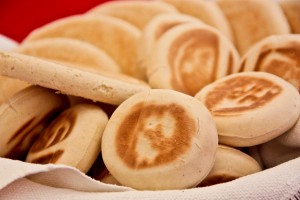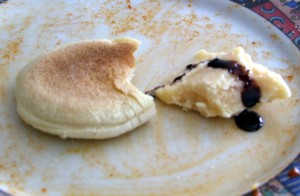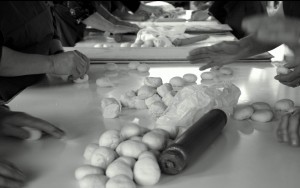Source: Modena’s traditional food products
It is the quintessential dish of Modena mountains, ancient mountain bread, circular, obtained by a clever mixture of wheat flour, water, salt and yeast, which are formed balls or discs with a diameter of 6-10 cm . In some variations is also added a pinch of sodium bicarbonate, and a small amount of fat such as lard, oil (olive or sunflower), cream, or milk. Sodium bicarbonate, in some recipes, completely replaces the yeast, thereby transforming Tigelle in an unleavened bread.

Traditional cooking was done by stacking pasta alternating with clay discs (called “tigelle”) previously red-hot in the chimney with leaves of chestnut or walnut. These wheels were about 15 cm in diameter and one-half inch thick, traditionally formed with a land of chestnut finely ground and molded into a wooden mold with engravings in low relief (geometric or floral decorations which then remained printed on the dough during the baking ) and then dried and cooked.
With appropriate skill, cook moved periodically elements of the stack to make uniform and check the progress of cooking. Currently, the cooking is usually carried out in a faster way, placing the disks of dough between two plates of a refractory material or metal (called “cottole”), in machines specially made for the purpose, powered by gas or electricity. The most common tool for family use is an aluminum mold which can contain from 4 to 7 crescentine.
It is a traditional food product listed with the names of “tigella modenese”, “tigèla modenese”, “crescentina modenese”, “cherscènta modenese” and is very consumed during the holidays and festivals; is prepared in almost all restaurants of Modena, Bologna and Reggio Emilia.
The collective mark “Tradizione e Sapori di Modena” is aimed at the protection of typical food Modena. The brand is owned by the Chamber of Commerce of Modena, who supervises the correct use of the same directly or through the use of audits of a third and independent monitoring organization. For more information: http://www.crescentinadimodena.it/

It is traditionally eaten warm, open in half and stuffed with pesto, with addition of grated Parmigiano Reggiano. It can be enjoyed with any type of cold cut and soft cheese, also does not mind at all “cacciatora” sauces, and even as a dessert, Nutella.
Visit online store

